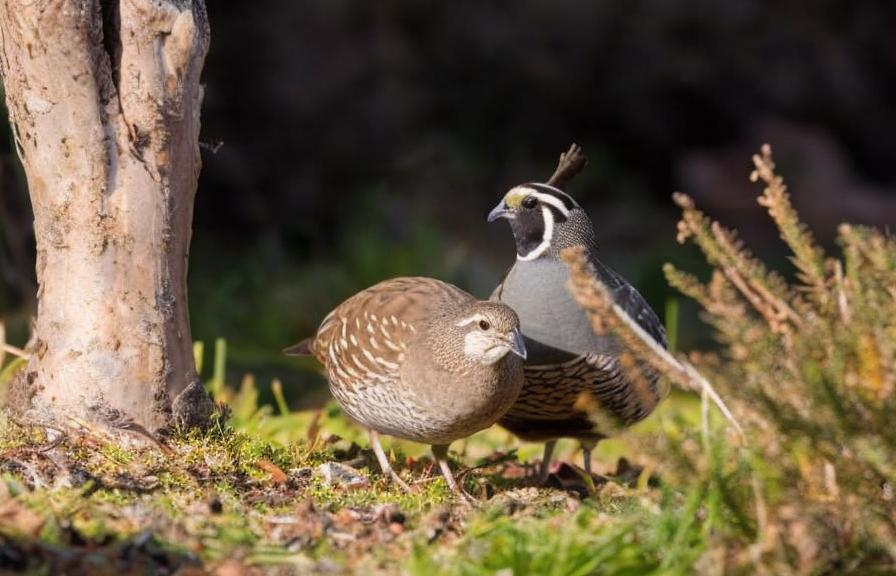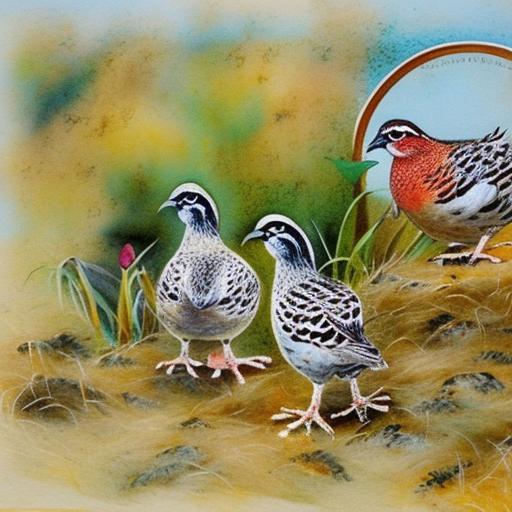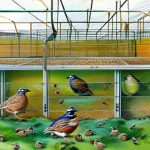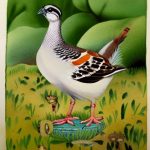Proper housing is crucial for quail breeding as it directly impacts the health, well-being, and productivity of the birds. Quails are sensitive creatures that require a safe and comfortable environment to thrive and reproduce. Inadequate housing can lead to stress, disease, and even death among the quails, which can significantly impact breeding success and overall profitability. Additionally, proper housing also plays a key role in maintaining the cleanliness of the breeding area, which is essential for preventing the spread of diseases and ensuring the health of the quails.
Furthermore, proper housing provides the necessary space and structure for quails to engage in natural behaviors such as nesting, foraging, and dust bathing. These behaviors are not only important for the physical health of the quails but also for their mental well-being. When quails are able to exhibit natural behaviors, they are less likely to experience stress and behavioral issues, which can have a positive impact on breeding success. Overall, proper housing is essential for creating a conducive environment for quail breeding, ensuring the health and well-being of the birds, and maximizing breeding productivity.
Key Takeaways
- Proper housing is crucial for successful quail breeding
- There are different types of cages suitable for quail breeding
- Factors to consider when choosing a cage include size, material, and ventilation
- The ideal cage environment for quail breeding includes proper lighting, temperature, and bedding
- Regular maintenance and cleaning of quail breeding cages is essential for the health of the birds
Types of Cages for Quail Breeding
There are several types of cages that are commonly used for quail breeding, each with its own advantages and disadvantages. One popular option is the wire cage, which provides good ventilation and allows for easy cleaning. Wire cages also prevent the accumulation of waste and provide a sturdy structure for the quails. Another option is the plastic or wooden cage, which provides better insulation and protection from the elements. These cages are also quieter and can provide a more natural environment for the quails.
In addition to traditional cages, some breeders also use battery cages, which are stacked vertically to maximize space efficiency. These cages are often used in commercial quail breeding operations and provide a cost-effective way to house a large number of birds. Finally, some breeders opt for aviary-style cages, which provide a more spacious and natural environment for the quails to move around and engage in natural behaviors. Each type of cage has its own unique features and benefits, and the choice of cage will depend on factors such as space availability, budget, and personal preferences.
Factors to Consider When Choosing a Cage for Quail Breeding
When choosing a cage for quail breeding, there are several important factors to consider to ensure the well-being and productivity of the birds. Firstly, the size of the cage is crucial, as it directly impacts the comfort and behavior of the quails. The cage should provide enough space for the quails to move around freely, stretch their wings, and engage in natural behaviors such as nesting and dust bathing. Additionally, overcrowding can lead to stress, aggression, and reduced breeding success among the quails.
Another important factor to consider is ventilation. Proper ventilation is essential for maintaining air quality inside the cage, preventing the buildup of ammonia from waste, and regulating temperature and humidity levels. Inadequate ventilation can lead to respiratory issues and heat stress among the quails, which can have a negative impact on breeding success. Furthermore, the material of the cage is also important to consider. Wire cages provide good ventilation and easy cleaning but may not offer as much insulation as plastic or wooden cages. The material should be durable, non-toxic, and easy to clean to ensure the health and safety of the quails.
Additionally, it’s important to consider the design of the cage, including features such as feeders, waterers, nesting boxes, and perches. These features should be strategically placed to provide easy access for the quails and to promote natural behaviors. Finally, the location of the cage is also an important factor to consider. The cage should be placed in a quiet area away from potential predators, extreme temperatures, and drafts. Overall, choosing the right cage for quail breeding requires careful consideration of factors such as size, ventilation, material, design, and location to ensure the health and productivity of the birds.
Setting Up the Ideal Environment Inside the Cage for Quail Breeding
Creating an ideal environment inside the cage is essential for successful quail breeding. The environment should mimic the natural habitat of quails as much as possible to promote natural behaviors and ensure the well-being of the birds. One important aspect of setting up the ideal environment is providing suitable bedding material. Bedding material such as straw, wood shavings, or sand should be used to create a comfortable and clean surface for the quails to walk on and nest in. The bedding material should be regularly replaced to maintain cleanliness and prevent the buildup of waste.
Furthermore, providing appropriate lighting is crucial for regulating the reproductive cycle of quails. Natural or artificial lighting can be used to simulate daylight hours and promote breeding behavior among the quails. Additionally, providing a balanced diet is essential for maintaining the health and productivity of the birds. Quails should have access to a high-quality feed that is specifically formulated for their nutritional needs. Water should also be readily available at all times to prevent dehydration and ensure proper digestion.
In addition to basic necessities such as bedding, lighting, feed, and water, it’s important to provide enrichment items inside the cage to promote natural behaviors. This can include perches for roosting, nesting boxes for laying eggs, and dust bathing areas for grooming. These enrichment items not only promote natural behaviors but also help reduce stress and boredom among the quails. Overall, setting up the ideal environment inside the cage involves providing suitable bedding material, appropriate lighting, a balanced diet, access to water, and enrichment items to ensure the health and productivity of the birds.
Maintenance and Cleaning of Quail Breeding Cages
Regular maintenance and cleaning of quail breeding cages are essential for ensuring the health and well-being of the birds and maximizing breeding productivity. Proper maintenance involves regularly inspecting the cages for any signs of damage or wear and tear. Any damaged or worn-out parts should be repaired or replaced promptly to prevent injury to the quails or escape from the cage. Additionally, regular cleaning is crucial for preventing the buildup of waste and maintaining a clean and hygienic environment for the quails.
Cleaning involves removing soiled bedding material, droppings, feathers, and any leftover feed from the cage on a regular basis. The frequency of cleaning will depend on factors such as cage size, number of birds housed, and environmental conditions. In addition to regular cleaning, disinfection should also be carried out periodically to prevent the spread of diseases among the quails. Disinfection involves using appropriate cleaning agents or disinfectants to kill bacteria, viruses, parasites, and other pathogens that may be present in the cage.
Furthermore, maintaining proper ventilation inside the cage is essential for preventing the buildup of ammonia from waste and regulating temperature and humidity levels. Ventilation systems should be regularly inspected and cleaned to ensure optimal air quality inside the cage. Additionally, waterers and feeders should be regularly cleaned and sanitized to prevent contamination and ensure access to clean water and feed for the quails. Overall, regular maintenance and cleaning of quail breeding cages are essential for preventing disease outbreaks, ensuring a clean and hygienic environment for the birds, and maximizing breeding productivity.
Common Mistakes to Avoid When Using Cages for Quail Breeding

When using cages for quail breeding, there are several common mistakes that breeders should avoid to ensure the health and productivity of the birds. One common mistake is overcrowding cages with too many birds. Overcrowding can lead to stress, aggression, reduced breeding success, and an increased risk of disease outbreaks among the quails. It’s important to provide enough space for the quails to move around freely, stretch their wings, and engage in natural behaviors.
Another common mistake is neglecting proper ventilation inside the cage. Inadequate ventilation can lead to respiratory issues, heat stress, and poor air quality inside the cage. Proper ventilation is essential for regulating temperature and humidity levels, preventing the buildup of ammonia from waste, and ensuring optimal air quality for the quails. Additionally, using inappropriate bedding material or failing to regularly replace soiled bedding material is another common mistake that can lead to unsanitary conditions inside the cage.
Furthermore, neglecting regular maintenance and cleaning of cages is a common mistake that can lead to disease outbreaks and reduced breeding productivity. Regular inspection, cleaning, disinfection, and maintenance are essential for preventing disease outbreaks and maintaining a clean and hygienic environment for the quails. Finally, failing to provide appropriate enrichment items inside the cage can lead to stress and boredom among the quails. Enrichment items such as perches, nesting boxes, and dust bathing areas are essential for promoting natural behaviors and reducing stress among the birds.
Tips for Successful Quail Breeding Using Cages
To ensure successful quail breeding using cages, there are several tips that breeders can follow to maximize productivity and ensure the health and well-being of the birds. Firstly, it’s important to choose a suitable cage size that provides enough space for the quails to move around freely and engage in natural behaviors. Overcrowding should be avoided to prevent stress, aggression, reduced breeding success, and disease outbreaks among the birds.
Additionally, providing proper ventilation inside the cage is crucial for maintaining optimal air quality and regulating temperature and humidity levels. Ventilation systems should be regularly inspected and cleaned to ensure proper airflow inside the cage. Furthermore, providing appropriate bedding material such as straw or wood shavings is essential for creating a comfortable surface for the quails to walk on and nest in.
In addition to basic necessities such as bedding material and ventilation, providing enrichment items inside the cage is important for promoting natural behaviors among the quails. This can include perches for roosting, nesting boxes for laying eggs, dust bathing areas for grooming, and toys for mental stimulation. Enrichment items help reduce stress and boredom among the birds while promoting natural behaviors.
Finally, regular maintenance and cleaning of cages are essential for preventing disease outbreaks and maintaining a clean and hygienic environment for the quails. This involves regularly inspecting cages for damage or wear and tear, cleaning soiled bedding material and waste from the cage, disinfecting surfaces periodically, maintaining proper ventilation systems, and regularly cleaning waterers and feeders.
In conclusion, proper housing is crucial for quail breeding as it directly impacts their health, well-being, and productivity. There are several types of cages that can be used for quail breeding including wire cages, plastic or wooden cages, battery cages or aviary-style cages each with its own advantages depending on factors such as space availability budget or personal preferences.
When choosing a cage it’s important to consider factors such as size ventilation material design location among others in order to ensure that it provides enough space good ventilation is made from durable non-toxic materials has strategic features like feeders waterers nesting boxes perches among others.
Setting up an ideal environment inside a cage involves providing suitable bedding material appropriate lighting balanced diet access to water enrichment items among others in order to mimic their natural habitat promote natural behaviors ensure their well-being.
Regular maintenance cleaning disinfection proper ventilation among others are essential practices when it comes to maintaining a clean hygienic environment preventing disease outbreaks ensuring optimal air quality maximizing breeding productivity.
Common mistakes when using cages include overcrowding neglecting proper ventilation using inappropriate bedding material neglecting regular maintenance cleaning among others which can lead to stress aggression reduced breeding success disease outbreaks among others.
To ensure successful quail breeding using cages it’s important to choose a suitable cage size provide proper ventilation appropriate bedding material enrichment items among others while following regular maintenance cleaning practices in order to maximize productivity ensure their health well-being.
To ensure successful quail breeding using cages, it’s important to choose a suitable cage size that allows for adequate space for the quail to move around and exhibit natural behaviors. Proper ventilation is essential to maintain air quality and prevent the buildup of harmful gases. Using appropriate bedding material, such as pine shavings or straw, will provide a comfortable and clean environment for the quail. Enrichment items, such as perches and nesting boxes, should be provided to encourage natural behaviors and reduce stress. Regular maintenance and cleaning practices are necessary to prevent the spread of disease and ensure the overall health and well-being of the quail. By following these guidelines, breeders can maximize productivity and ensure the success of their quail breeding operation.
If you’re looking for tips on quail breeding, you may also be interested in learning about the mating season for turkeys. Understanding the mating behaviors of turkeys can provide valuable insights into managing quail breeding. Check out this informative article on mating season for turkeys to gain a deeper understanding of avian breeding behaviors and how they can be applied to your quail breeding practices.
FAQs
What are the benefits of using cages for quail breeding?
Cages provide a controlled environment for quail breeding, allowing for easy monitoring of the birds and their eggs. They also help to prevent overcrowding and reduce the risk of disease transmission.
What should be considered when choosing cages for quail breeding?
When choosing cages for quail breeding, factors such as size, material, ventilation, and ease of cleaning should be considered. The cages should also provide enough space for the quails to move around and exhibit natural behaviors.
How should cages for quail breeding be set up?
Cages for quail breeding should be set up in a well-ventilated area with access to natural light. The cages should be equipped with nesting boxes, feeders, and waterers, and should be kept clean to ensure the health and well-being of the quails.
What are the different types of cages used for quail breeding?
There are various types of cages used for quail breeding, including wire cages, plastic cages, and wooden cages. Each type has its own advantages and disadvantages, and the choice of cage will depend on factors such as cost, durability, and ease of maintenance.
How many quails can be housed in a single cage for breeding?
The number of quails that can be housed in a single breeding cage will depend on the size of the cage and the breed of quail. As a general guideline, it is recommended to provide at least 1 square foot of space per quail to ensure their comfort and well-being.
Meet Walter, the feathered-friend fanatic of Florida! Nestled in the sunshine state, Walter struts through life with his feathered companions, clucking his way to happiness. With a coop that’s fancier than a five-star hotel, he’s the Don Juan of the chicken world. When he’s not teaching his hens to do the cha-cha, you’ll find him in a heated debate with his prized rooster, Sir Clucks-a-Lot. Walter’s poultry passion is no yolk; he’s the sunny-side-up guy you never knew you needed in your flock of friends!







